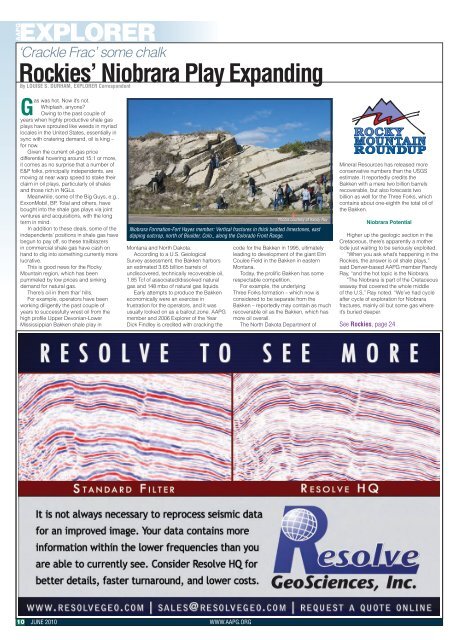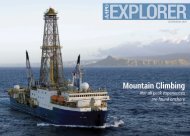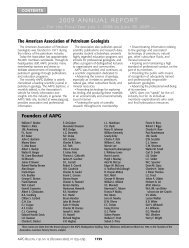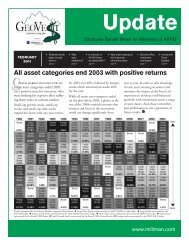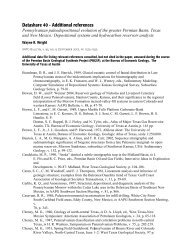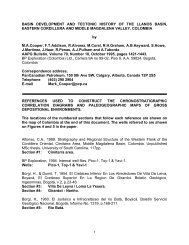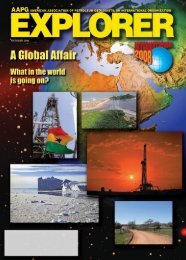AAPG Explorer - June 2010 - American Association of Petroleum ...
AAPG Explorer - June 2010 - American Association of Petroleum ...
AAPG Explorer - June 2010 - American Association of Petroleum ...
You also want an ePaper? Increase the reach of your titles
YUMPU automatically turns print PDFs into web optimized ePapers that Google loves.
<strong>AAPG</strong><br />
EXPLORER<br />
‘Crackle Frac’ some chalk<br />
Rockies’ Niobrara Play Expanding<br />
By LOUISE S. DURHAM, EXPLORER Correspondent<br />
Gas was hot. Now it’s not.<br />
Whiplash, anyone?<br />
Owing to the past couple <strong>of</strong><br />
years when highly productive shale gas<br />
plays have sprouted like weeds in myriad<br />
locales in the United States, essentially in<br />
sync with cratering demand, oil is king –<br />
for now.<br />
Given the current oil-gas price<br />
differential hovering around 15:1 or more,<br />
it comes as no surprise that a number <strong>of</strong><br />
E&P folks, principally independents, are<br />
moving at near warp speed to stake their<br />
claim in oil plays, particularly oil shales<br />
and those rich in NGLs.<br />
Meanwhile, some <strong>of</strong> the Big Guys, e.g.,<br />
ExxonMobil, BP, Total and others, have<br />
bought into the shale gas plays via joint<br />
ventures and acquisitions, with the long<br />
term in mind.<br />
In addition to these deals, some <strong>of</strong> the<br />
independents’ positions in shale gas have<br />
begun to pay <strong>of</strong>f, so these trailblazers<br />
in commercial shale gas have cash on<br />
hand to dig into something currently more<br />
lucrative.<br />
This is good news for the Rocky<br />
Mountain region, which has been<br />
pummeled by low prices and sinking<br />
demand for natural gas.<br />
There’s oil in them thar’ hills.<br />
For example, operators have been<br />
working diligently the past couple <strong>of</strong><br />
years to successfully wrest oil from the<br />
high pr<strong>of</strong>ile Upper Devonian-Lower<br />
Mississippian Bakken shale play in<br />
Montana and North Dakota.<br />
According to a U.S. Geological<br />
Survey assessment, the Bakken harbors<br />
an estimated 3.65 billion barrels <strong>of</strong><br />
undiscovered, technically recoverable oil,<br />
1.85 Tcf <strong>of</strong> associated/dissolved natural<br />
gas and 148 mbo <strong>of</strong> natural gas liquids.<br />
Early attempts to produce the Bakken<br />
economically were an exercise in<br />
frustration for the operators, and it was<br />
usually looked on as a bailout zone. <strong>AAPG</strong><br />
member and 2006 <strong>Explorer</strong> <strong>of</strong> the Year<br />
Dick Findley is credited with cracking the<br />
10 JUNE <strong>2010</strong> WWW.<strong>AAPG</strong>.ORG<br />
Photos courtesy <strong>of</strong> Randy Ray<br />
Niobrara Formation-Fort Hayes member: Vertical fractures in thick bedded limestones, east<br />
dipping outcrop, north <strong>of</strong> Boulder, Colo., along the Colorado Front Range.<br />
code for the Bakken in 1995, ultimately<br />
leading to development <strong>of</strong> the giant Elm<br />
Coulee Field in the Bakken in eastern<br />
Montana.<br />
Today, the prolific Bakken has some<br />
respectable competition.<br />
For example, the underlying<br />
Three Forks formation – which now is<br />
considered to be separate from the<br />
Bakken – reportedly may contain as much<br />
recoverable oil as the Bakken, which has<br />
more oil overall.<br />
The North Dakota Department <strong>of</strong><br />
Mineral Resources has released more<br />
conservative numbers than the USGS<br />
estimate. It reportedly credits the<br />
Bakken with a mere two billion barrels<br />
recoverable, but also forecasts two<br />
billion as well for the Three Forks, which<br />
contains about one-eighth the total oil <strong>of</strong><br />
the Bakken.<br />
Niobrara Potential<br />
Higher up the geologic section in the<br />
Cretaceous, there’s apparently a mother<br />
lode just waiting to be seriously exploited.<br />
“When you ask what’s happening in the<br />
Rockies, the answer is oil shale plays,”<br />
said Denver-based <strong>AAPG</strong> member Randy<br />
Ray, “and the hot topic is the Niobrara.<br />
“The Niobrara is part <strong>of</strong> the Cretaceous<br />
seaway that covered the whole middle<br />
<strong>of</strong> the U.S,” Ray noted. “We’ve had cycle<br />
after cycle <strong>of</strong> exploration for Niobrara<br />
fractures, mainly oil but some gas where<br />
it’s buried deeper.<br />
See Rockies, page 24


